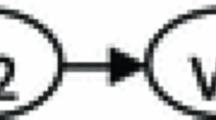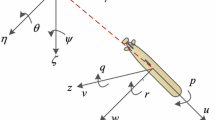Abstract
This article considers the cooperative path-following control problem for a cluster of networked autonomous underwater vehicles (AUVs) suffering from unknown dynamics and ocean disturbances. By virtue of light-of-sight guidance and undirected graph, a synchronized guidance approach is created for underactuated AUVs, where multiple geometry curves are taken into account and information exchanges-related path variables are utilized, and thereby enabling AUVs to be synchronized and stabilized into a desired formation pattern. Within the distributed surge and yaw controller design, the unknown dynamics and the ocean disturbances are lumped together by using a linear state transformation. And a prediction-based fuzzy state observer (PFSO) is devised for estimating the unmeasured lumped states, where prediction errors are used to update fuzzy weights. Through the Lyapunov analysis, it is proven that surge and yaw-tracking errors and state observation errors are uniformly ultimately bounded. Simulation verifications are deployed to illustrate the efficacy and superiority of the designed method.











Similar content being viewed by others
References
Li, J., Du, J.L., Chang, W.J.: Robust time-varying formation control for underactuated autonomous underwater vehicles with disturbances under input saturation. Ocean Eng. 179, 180–188 (2019)
Xie, W.J., Ma, B.L., Fernando, T., et al.: A new formation control of multiple underactuated surface vessels. Int. J. Control 91(5), 1011–1022 (2018)
Peng, Z.H., Wang, D., Wang, H.: Coordinated formation pattern control of multiple marine surface vehicles with model uncertainty and time-varying ocean currents. Neural Comput. Appl. 25(7–8), 1771–1783 (2014)
Ghommam, J., Mnif, F.: Coordinated path-following control for a cluster of underactuated surface vessels. IEEE Trans. Industr. Electron. 56(10), 3951–3963 (2019)
Liu, L., Wang, D., Peng, Z.H.: Coordinated path following of multiple underactuated marine surface vehicles along one curve. ISA Trans. 64, 258–268 (2016)
He, S.D., Wang, M., Dai, S.L., et al.: Leader-follower formation control of USVs with prescribed performance and collision avoidance. IEEE Trans. Industr. Inf. 15(1), 572–581 (2019)
Belleter, D., Pettersen, K.: Underactuated leader-follower synchronisation for multi-agent systems with rejection of unknown disturbances. In: Proceedings of the 2015 American control conference, pp. 3094–3100 (2015)
Wang, W., Tong, S., Wang, D.: Adaptive fuzzy containment control of nonlinear systems with unmeasurable states. IEEE Trans. Cyber. 49(3), 961–973 (2019)
Dong, X.W., Hu, G.Q.: Time-varying formation tracking for linear multi-agent systems with multiple leaders. IEEE Trans. Autom. Control 62(7), 3658–3664 (2017)
Li, Z.K., Ren, W., Liu, X.D., et al.: Distributed containment control of multi-agent systems with general linear dynamics in the presence of multiple leaders. Int. J. Robust Nonlinear Control 23(5), 534–547 (2013)
Qin, H.D., Chen, H., Sun, Y.C., et al.: Distributed finite-time fault-tolerant containment control for multiple ocean bottom flying node systems with error constraints. Ocean Eng. 189, 1–15 (2019)
Qin, H.D., Chen, H., Sun, Y.C. et al.: Distributed finite-time fault-tolerant containment control for multiple ocean bottom flying nodes. J. Frank. Inst. https://doi.org/10.1016/j.jfranklin.2019.05.034
Chen, J., Gan, M.G., Huang, J., et al.: Formation control of multiple Euler–Lagrange systems via null-space-based behavioral control. Sci. China Inf. Sci. 59(1), 1–11 (2016)
Lee, G., Chwa, D., et al.: Decentralized behavior-based formation control of multiple robots considering obstacle avoidance. Intel. Serv. Robot. 11(1), 127–138 (2018)
Mehrjerdi, H., Ghomman, J., Saan, M., et al.: Nonlinear coordination control for a cluster of mobile robots using a virtual structure. Mechatronics 21(7), 1147–1155 (2011)
Kanjanawanishkul, K.: Coordinated path following for mobile robots using a virtual structure strategy with model predictive control. Automatika 55(3), 287–298 (2014)
Wang, Y.T, Yao, Y.: Consensus Path-following control of multiple underactuated unmanned underwater vehicles. Complexity, 1–8 (2018)
Wang, Y.T, Yan, W.S.: Path parameters consensus based formation control of multiple autonomous underwater vehicles in the presence of ocean currents. In: Proceedings of the 17th international conference on methods and models in automation and robotics, pp. 427–432 (2012)
Ji, J., Khajepour, A., Melek, W.W., et al.: Path planning and tracking for robot collision avoidance based on model predictive control with multiconstraints. IEEE Trans. Veh. Technol. 66(2), 952–964 (2017)
Palacios, L., Ceriotti, M., Radice, G.: Close proximity formation flying via linear quadratic tracking controller and artificial potential function. Adv. Space Res. 56(10), 2167–2176 (2015)
Cui, R.X., Ge, S.S., How, B.V.E., et al.: Leader–follower formation control of underactuated autonomous underwater vehicles. Ocean Eng. 37(17–18), 1491–1502 (2010)
Wang, H., Wang, D., Peng, Z.H., et al.: Adaptive dynamic surface control for cooperative path following of underactuated marine surface vehicles via fast learning. IET Control Theory Appl. 7(15), 1888–1898 (2013)
Wang, H., Wang, D., Peng, Z.H.: Adaptive dynamic surface control for cooperative path following of marine surface vehicles with input saturation. Nonlinear Dyn. 77(1–2), 107–117 (2014)
Qiao, L., Zhang, W.D.: Trajectory tracking control of AUVs via adaptive fast nonsingular integral terminal sliding mode control. IEEE Trans. Ind. Inf. 16(2), 1248–1258 (2020)
Qiao, L., Zhang, W.D.: Double-loop integral terminal sliding mode tracking control for UUVs with adaptive dynamic compensation of uncertainties and disturbances. IEEE J. Oceanic Eng. 44(1), 29–53 (2019)
Liang, X., Qu, X.R., Wang, N., et al.: A novel distributed and self-organized swarm control framework for underactuated unmanned marine vehicles. IEEE Access 7, 112703–112712 (2019)
Liang, X., Qu, X.R., Wang, N., et al.: Three-dimensional trajectory tracking of an underactuated AUV based on fuzzy dynamic surface control. IET Intel. Transport Syst. 14(5), 364–370 (2020)
Tee, K.P., Ge, S.Z.S.: Control of fully actuated ocean surface vessels using a class of feedforward approximators. IEEE Trans. Control Syst. Technol. 14(4), 750–756 (2006)
Liang, X., Qu, X.R., Wan, L., et al.: Three-dimensional path following of an underactuated AUV based on fuzzy backstepping sliding mode control. Int. J. Fuzzy Syst. 20(2), 640–649 (2018)
Yu, C.Y., Xiang, X.B.: 3D path following for underactuated AUV via nonlinear fuzzy controller. Proc. Oceans 2016, 1–7 (2016)
Wang, N., Sun, Z., Su, S.F., et al.: Fuzzy uncertainty observer-based path-following control of underactuated marine vehicles with unmodeled dynamics and disturbances. Int. J. Fuzzy Syst. 20(8), 2593–2604 (2018)
Hou, Z.G., Cheng, L., Tan, M.: Decentralized robust adaptive control for the multi-agent system consensus problem using neural networks. IEEE Trans. Syst. Man Cybernetics Part B -Cybernetics 39(3), 636–647 (2009)
Fossen, T.I.: Handbook of marine craft hydrodynamics and motion control. Wiley, Chichester (2011)
Kawabata, K., Ma, L., Xue, J.R., et al.: A path generation for automated vehicle based on Bezier curve and via-points. Robot. Autonom. Syst. 74, 243–252 (2015)
Lekkas, A.M., Fossen, T.I.: Integral LOS path following for curved paths based on a monotone cubic hermite spline parametrization. IEEE Trans. Control Syst. Technol. 22(6), 2287–2301 (2014)
Chen, Y.Y., Tian, Y.P.: A curve extension design for coordinated path following control of unicycles along given convex loops. Int. J. Control 84(10), 1729–1745 (2014)
Qu, X.R., Liang, X., Hou, Y.H. et al.: Path-following control of unmanned surface vehicles with unknown dynamics and unmeasured velocities. J. Marine Sci. Technol. in press (2020)
Wang, N., Pan, X.X.: Path-following of autonomous underactuated ships: a translation-rotation cascade control approach. IEEE-ASME Trans. Mech. 24(6), 2583–2593 (2019)
Liu, L., Wang, D., Peng, Z.H.: Path following of marine surface vehicles with dynamical uncertainty and time-varying ocean disturbances. Neurocomputing 173, 799–808 (2016)
Wang, N., Sun, Z., Yin, J.C., et al.: Fuzzy unknown observer-based robust adaptive path following control of underactuated surface vehicles subject to multiple unknowns. Ocean Eng. 176, 57–64 (2019)
Liang, X., Qu, X.R., Wang, N., et al.: Swarm control with collision avoidance for multiple underactuated surface vehicles. Ocean Eng. 191, 1–10 (2019)
Liang, X., Qu, X.R., Hou, Y.H., et al.: Distributed coordinated tracking control of multiple unmanned surface vehicles under complex marine environments. Ocean Eng. 205, 1–9 (2020)
Wang, N., Karimi, H.R., Li, H.Y., et al.: Accurate trajectory tracking of disturbed surface vehicles: a finite-time control approach. IEEE-ASME Trans. Mech. 24(3), 1064–1074 (2019)
Wang, N., Deng, Z.C.: Finite-time fault estimator based fault-tolerance control for a surface vehicle with input saturations. IEEE Trans. Ind. Inf. 16(2), 1172–1181 (2020)
Acknowledgements
This work was supported in part by the National Natural Science Foundation of China under Grant 51879023, in part by the Research Fund from Science and Technology on Underwater Vehicle Technology under Grant 6142215180102, in part by the LiaoNing Revitalization Talents Program under Grant XLYC1907180, and in part by the Liaoning Provincial Natural Science Foundation of China under Grant 2019-KF-01-16, and in part by the Innovation Project for Dalian Maritime University Double First-Class Construction under Grant BSCXXM024.
Author information
Authors and Affiliations
Corresponding author
Rights and permissions
About this article
Cite this article
Qu, X., Liang, X. & Hou, Y. Fuzzy State Observer-Based Cooperative Path-Following Control of Autonomous Underwater Vehicles with Unknown Dynamics and Ocean Disturbances. Int. J. Fuzzy Syst. 23, 1849–1859 (2021). https://doi.org/10.1007/s40815-020-00943-5
Received:
Revised:
Accepted:
Published:
Issue Date:
DOI: https://doi.org/10.1007/s40815-020-00943-5




